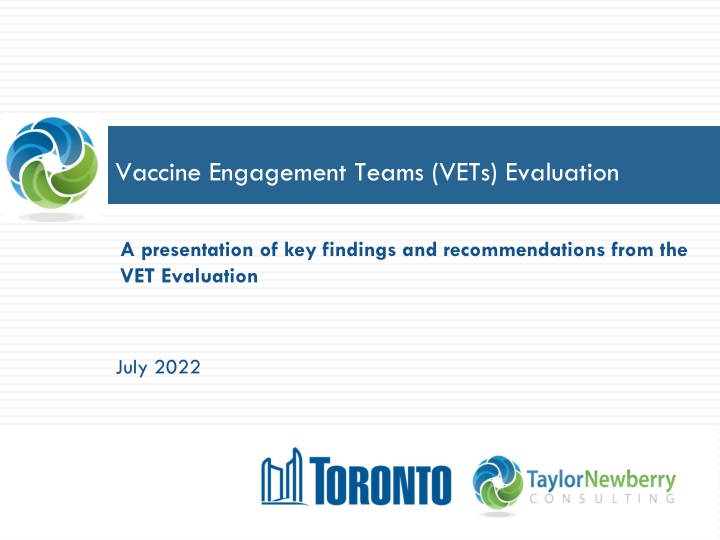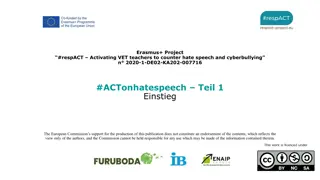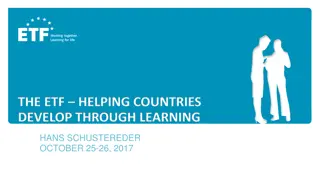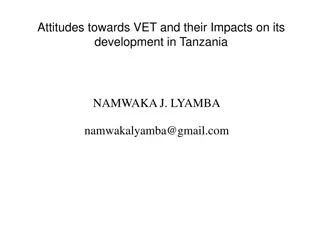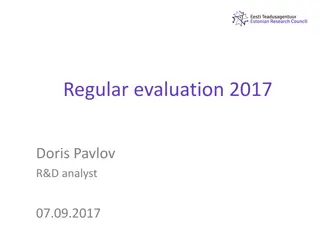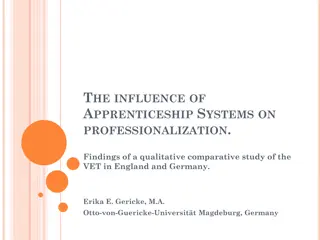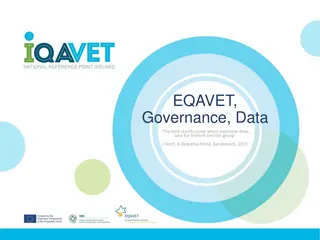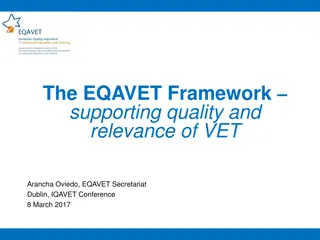Key Findings and Recommendations from VET Evaluation July 2022
A presentation of key findings and recommendations from the Vaccine Engagement Teams (VETs) Evaluation in July 2022, highlighting increased vaccine confidence, effective ambassador outreach, and innovative community health programming. The evaluation assessed the VETs' achievements, identified barriers and facilitators, and outlined the key components of the VET model to improve vaccine equity and access in Toronto.
Download Presentation

Please find below an Image/Link to download the presentation.
The content on the website is provided AS IS for your information and personal use only. It may not be sold, licensed, or shared on other websites without obtaining consent from the author.If you encounter any issues during the download, it is possible that the publisher has removed the file from their server.
You are allowed to download the files provided on this website for personal or commercial use, subject to the condition that they are used lawfully. All files are the property of their respective owners.
The content on the website is provided AS IS for your information and personal use only. It may not be sold, licensed, or shared on other websites without obtaining consent from the author.
E N D
Presentation Transcript
Vaccine Engagement Teams (VETs) Evaluation A presentation of key findings and recommendations from the VET Evaluation July 2022
Presentation Outline Presentation Outline Background What issue do the VETs address? Evaluation purpose Evaluation methodology Key findings 1. Increased Vaccine Confidence, Access & Equity 2. Effective Ambassador Outreach & Engagement 3. Effective Ambassador Training & Support 4. A Coordinated Response from the City of Toronto 5. An Innovative & Effective Model for Community & Health Programming Key learnings
Background Background $9.5 million grant for VETs between March 2021 and March 2022 To increase vaccine confidence and access via equity-based engagement and mobilization 17 geographic- and population-based consortiums of community agencies Community Ambassadors act as key points of contact in their neighbourhoods Social Development, Finance and Administration (SDFA) oversees coordination and monitoring, in partnership with Toronto Public Health (TPH) Strategic Communications (SC) and Shelter, Support and Housing Administration (SSHA) provide support to SDFA, community agency partners and Community Ambassadors
What Issue do the VETs Address? What Issue do the VETs Address? COVID-19 is an infectious disease that can be fatal COVID-19 vaccines are life-saving health interventions Community Ambassadors help improve access to COVID-19 vaccines for as many people as possible VETs are a bridge between City of Toronto residents and health, community, and social services
Questions Evaluation Objectives & Questions Evaluation Objectives 1. To assess the extent to which the VETs achieved their stated outcomes, 2. To identify facilitators and barriers to achieving these outcomes, and 3. To identify the key ingredients of the VET model Stated VET Program Outcomes Increase vaccine confidence and promote vaccine uptake Improve vaccine access by reducing barriers and providing resources to access the vaccination programs Increase vaccine equity for populations most negatively affected by COVID-19 Increase Community Ambassador skills and leadership capacity Increase cross-sector and stakeholder collaboration Increase inter-divisional collaboration among City divisions
Questions Evaluation Objectives & Questions Evaluation Questions 1. To what extent did the initiative increase vaccine confidence, reduce barriers to vaccine access, and increase vaccine uptake among equity- deserving groups? 2. To what extent did the initiative increase consortium-based collaboration between community and health services, and how responsive was it to each stakeholder's needs? 3. To what extent were the initiative s Community Ambassadors effective and responsive to the needs of equity-deserving groups? 4. To what extent was the initiative's model effective in building institutional relationships between community services and health services with and within City divisions?
Evaluation Methodology Evaluation Methodology Methodology Mixed methods approach (qualitative and quantitative) Data collection period VET Evaluation: July 2021 - March 2022
Evaluation Methodology Evaluation Methodology Data sources 1. Ambassador and agency representative surveys 2. Residents-engaged survey 3. VET reporting: Ambassador status reports Consortium coordinator status reports Emerging issues and concerns by consortium summaries Consortium status updates 4. Focus groups and key informant interviews with Ambassadors, Coordinators, agency representatives, and SDFA staff
1. Increased Vaccine Confidence, Access & Equity Ambassadors consistently connected with community members who were vaccine hesitant and/or were experiencing barriers to access. Ambassadors outreach was highly effective in contributing to increased vaccine confidence, access, and uptake. City of Toronto-produced materials that were distributed to residents during outreach and were helpful in increasing vaccine confidence and access. A number of barriers to vaccine confidence and access persist, with vaccine safety reported to be the primary concern.
2. Effective Ambassador Outreach & Engagement Ambassadors implemented a range of engagement strategies that were responsive to local community needs. VETs engaged in multiple forms of outreach at any given time. o One-on-one conversations and social media outreach were reported to be the most effective outreach strategies. Effective outreach was facilitated by multilingual engagement, access to vaccination data, and door-to-door outreach initiatives.
3. Effective Ambassador Training & Support Ambassadors were satisfied with the training and support received from the City of Toronto and their VET; greater language options may increase accessibility even more. Ambassadors reported that the training provided to them increased their knowledge, skills, and confidence to do outreach and engagement. Ambassadors reported a high degree of satisfaction in their role. Safety of Ambassadors was a primary concern due to some encounters with the public; most reported having the knowledge and skills to remain safe while conducting outreach.
4. A Coordinated Response from the City of Toronto Key findings presented in the Interdivisional Partnership Evaluation report on VET relationships to the City of Toronto were consistent with findings of this evaluation. Examples include: o Ambassadors were satisfied with training provided by the City of Toronto; o Ambassadors recommended creating additional resources to support Ambassador mental health and wellbeing, and safety; o Communication, collaboration, and trust between the VETs and the City of Toronto was seen as important feature.
4. A Coordinated Response from the City of Toronto The fast pace of planning and initialization in March 2021: o Constrained communication and collaboration, including around the administrative structure of the program (e.g., funding, reporting); and, o Resulted in reduced clarity around project direction, decision- making processes, and leadership structures. The City s project team was expanded as demand for support and increased communication with community partners became evident.
5. An Innovative & Effective Model for Community & Health Programming Key Characteristics Supporting the Model s Success Ambassadors are uniquely positioned to be the human connection between services and Toronto residents. The community-centred structure offered flexibility. Trusting, supportive, transparent, and responsive relationships among all stakeholders.
5. An Innovative & Effective Model for Community & Health Programming Opportunities for Improvement with the VET Model More streamlined integration of population-based collaboratives into a place-based model; More information for community agencies to define scope and outcomes for VETs; More streamlined communications and reporting between various partners; Earlier opportunities for community input on implementation and for VETS on partnerships with vaccine clinic teams; and, Clearer funding alignment to programming and other agency resources.
VET Evaluation Key Learnings Key ingredients of the effective VET model: 1. The community-centred and community-led approach. 2. Peer-to-peer engagement work of Ambassadors. 3. Dedicated full-time Consortium Coordinator positions. 4. Multilingual approach to engagement. 5. Regular communication among all stakeholders. 6. Ongoing training and support for Ambassadors. 7. Pathways for skill development for Ambassadors. 8. Pathways for relationship building and collaboration.
VET Evaluation Key Learnings Key learnings to inform future applications of the VET model: Peer engagement is a valuable tool for increasing equity, especially in the context of public health campaigns. Early co-creation with community stakeholders can result in more relevant and sustainable program policies and implementation. Integration of an anchor agency approach may strengthen VET structure. Early clarity around roles, goals, and expectations for community agencies is critical. Population-based collaboratives have unique strengths that require special consideration in a predominantly geographic-based model. Clear and frequent communication amongst all stakeholders is vital; many channels should be used to achieve different needs.
